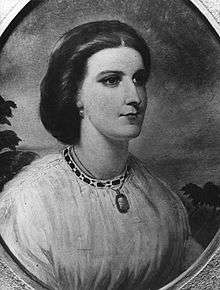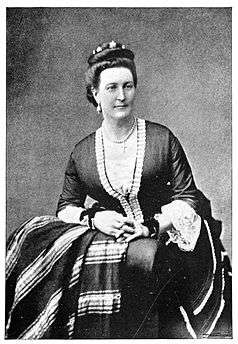Isabel Burton
| Lady Isabel Burton | |
|---|---|
 Lady Isabel Burton, 1861 | |
| Born |
Isabel Arundell 20 March 1831 London, England |
| Died |
22 March 1896 (aged 65) London, England |
| Resting place | Churchyard of St Mary Magdalen Roman Catholic Church Mortlake, London, England |
| Nationality | British |
| Religion | Roman Catholic |
| Spouse(s) | Richard Francis Burton (m. 1861–90) |

Isabel, Lady Burton (20 March 1831 – 22 March 1896) — née Isabel Arundell — was a writer and the wife and partner of explorer, adventurer, and writer Sir Richard Francis Burton (1821–1890).
Biography

Isabel Burton was the daughter of Hon. Henry Raymond Arundell (1799–1886) of Kenilworth, Warwickshire, nephew of James Everard Arundell (1785–1834), 10th Baron Arundell of Wardour.[1] Her mother, Eliza, was the sister of Robert Tolver Gerard (1808–1887), 13th Baronet of Bryn, Lancashire, and 1st Baron Gerard of Bryn.
Isabel was one of eleven children born into the House of Wardour, a respected and well-to-do Roman Catholic family in England. She grew up enmeshed in London society and attended the convent of the Canonesses of the Holy Sepulchre, where she excelled as a writer and in theological studies.
During the Crimean War, Isabel was refused three times in her quest to be a 'Nightingale nurse' and instead set up an group of 150 like-minded women from Catholic families known as the Stella Club to assist the wives and children of soldiers who had married without permission and for whom the army took no responsibility. Such women and children were often in dire circumstances at home. Isabel and her group went into the slums of London, against the advice of police, to distribute assistance.[2]
While on a school trip to Boulogne, she first met her future husband, Richard Burton, whom she claims to have fallen in love with immediately, though it would be another four years until their courtship began, and ten years until their marriage. Because of her strict Catholic background, her relationship with Burton caused strains within her family and she ultimately married him against the wishes of her parents. This was to be a major source of pain for her as the years progressed.
She was an intelligent, resourceful and devout woman, but is always seen in the shadow of her husband, one of the most famous of all Victorians. She was a strong supporter and advocate for her husband and assisted him on many of his most significant writings. He has credited her with being his most ardent supporter. He encouraged her to write and she wrote a number of books, including among them a history of their travels in Syria and Palestine, as well as an autobiography, published posthumously. Some scholars believe that Burton himself wrote under her name, though it is unclear.
She is perhaps best known for burning some of his papers and manuscripts after his death, including his revised translation of The Perfumed Garden, which was to be called The Scented Garden, and of which the largest part consisted of the usually unpublished final chapter dealing with pederasty, plus Burton's extensive (and comprehensive) notes on the subject.
In an appendix to her unfinished autobiography,[3] her posthumous collaborator William Henry Wilkins pointed out that she had a first offer of £6,000 for the manuscript, and moreover that she need never have disclosed her actions at all, or blamed them on her husband. He further claimed that she acted from a sincere belief that "out of a thousand men who read the work, 15 would read it in the scientific spirit in which it was written, and the other 985 solely for filth's sake", and feared that publication would blight, not her husband's worldly reputation – for his interest in the subject was notorious – but, by tempting others to sin, his prospects in the world to come.[4]
In spite of pain from cancer, she finished a two-volume biography of Burton, titled Richard, The Life of Captain Sir Richard Francis Burton, which was published on 11 July 1893.[5] Her own autobiography she completed with the help of W. H. Wilkins. The Romance of Isabel Burton was published in 1897.[5]
She moved to Eastbourne in September 1895 and returned to London in March 1896. She died in London on 22 March.[5] Her body and that of her husband lie in the churchyard of St Mary Magdalen Roman Catholic Church Mortlake in south west London, in an elaborate tomb in the shape of a Bedouin tent which she designed.[6] The coffins of Sir Richard and Lady Burton can be seen through a window at the rear of the tent, which can be accessed via a short fixed ladder. Next to the lady chapel in the church there is a memorial stained-glass window to Sir Richard, erected by Lady Isabel.
Bibliography
| Library resources about Isabel Burton |
| By Isabel Burton |
|---|
- The inner life of Syria, Palestine, and the Holy Land: from my private journal. London: H.S. King & Co., 1875.
- Arabia, Egypt, India: a narrative of travel. London: W. Mullan and Son, 1879.
- Prevention of cruelty, and anti-vivisection. London: William Mullan, 1879.
- The revival of Christianity in Syria: its miracles and martyrdoms. London : E. Stanford, 187-?.
- Iracema, the honey lips: a legend of Brasil by José de Alencar. Translated by Lady Isabel Burton. London: Bickers & Son, 1886. (New York: Luso-Brazilian Books, 2006. ISBN 0-85051-524-6)
- Lady Burton's edition of her husband's Arabian nights: translated literally from the Arabic by Sir Richard Francis Burton. London: Waterlow, 1886–1887.
- The life of Captain Sir Richd F. Burton. London: Chapman & Hall, 1893.
- The romance of Isabel, Lady Burton, the story of her life. London: Hutchinson & Co., 1897
- The passion-play at Ober-Ammergau. London: Hutchinson, 1900.
In popular culture
Fiona Shaw portrayed her in the 1990 movie Mountains of the Moon.
See also
References
Citations
- ↑ Lovell, Mary S. A Rage to Live, W.W. Norton, 1998
- ↑ Rappaport, Helen (2008). No Place for Ladies. Oakhill Publishing Limited. ISBN 1846483727.
- ↑ Appendix
- ↑ Wilkins, W. H. (1897). The Romance of Isabel Burton. London.
- 1 2 3 "After Sir Richard Burton's death". Local history notes – Sir Richard and Lady Isabel Burton. London Borough of Richmond upon Thames. Retrieved 11 October 2012.
- ↑ Cherry, Bridget and Pevsner, Nikolaus (1983). The Buildings of England – London 2: South. London: Penguin Books. p. 513. ISBN 0 14 0710 47 7.
Further information
- Works by Isabel Burton listed at The Online Books Page
- burtoniana.org/isabel/ has most of Isabel Burton's writings, as well as those by her husband Richard Burton.
- Burton, Isabel, Lady, 1831–1896 at gutenberg.org
- Burton, Isabel. The Romance of Isabel, Lady Burton
- Lovell, Mary S. A Rage to Live, W.W. Norton, 1998.
External links
- Works by Isabel Burton at Project Gutenberg
- Works by or about Isabel Burton at Internet Archive
- Works by Isabel Burton at LibriVox (public domain audiobooks)
